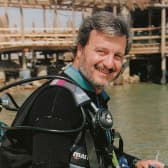Diving and Hyperbaric Physiology, Safety, and Medical Healthcare
A special issue of Healthcare (ISSN 2227-9032).
Deadline for manuscript submissions: 30 June 2024 | Viewed by 2531
Special Issue Editors
Interests: prevention of DCI in recreational and professional diving; hyperbaric medicine (ECHM); baromedicine; hyperbaric medicine; underwater and baromedical society; decompression sickness; diving; air embolism; remote emergency medical assistance; telemedicine in underwater and extreme environments
Special Issues, Collections and Topics in MDPI journals
Interests: diving pathophysiology; decompression illnesses; decompression algorithms; breath hold diving; extreme environments; telemedicine
Special Issues, Collections and Topics in MDPI journals
Special Issue Information
Dear Colleagues,
This Special Issue is focused on the role of advanced real-time field research in the definition of human adaptation to the underwater environment and to extreme environments in general, through the use of advanced, virtual augmented reality, AI and machine-learning-assisted, real-time physiological monitoring techniques, the definition of physio-pathological patterns and best safety standards for decompression after underwater immersion, and mechanisms of human adaptation to underwater immersion.
Prof. Dr. Alessandro Marroni
Dr. Danilo Cialoni
Guest Editors
Manuscript Submission Information
Manuscripts should be submitted online at www.mdpi.com by registering and logging in to this website. Once you are registered, click here to go to the submission form. Manuscripts can be submitted until the deadline. All submissions that pass pre-check are peer-reviewed. Accepted papers will be published continuously in the journal (as soon as accepted) and will be listed together on the special issue website. Research articles, review articles as well as short communications are invited. For planned papers, a title and short abstract (about 100 words) can be sent to the Editorial Office for announcement on this website.
Submitted manuscripts should not have been published previously, nor be under consideration for publication elsewhere (except conference proceedings papers). All manuscripts are thoroughly refereed through a single-blind peer-review process. A guide for authors and other relevant information for submission of manuscripts is available on the Instructions for Authors page. Healthcare is an international peer-reviewed open access semimonthly journal published by MDPI.
Please visit the Instructions for Authors page before submitting a manuscript. The Article Processing Charge (APC) for publication in this open access journal is 2700 CHF (Swiss Francs). Submitted papers should be well formatted and use good English. Authors may use MDPI's English editing service prior to publication or during author revisions.
Keywords
- diving pathophysiology
- decompression illnesses
- decompression algorithms
- breath-hold diving
- extreme environments
- telemedicine







